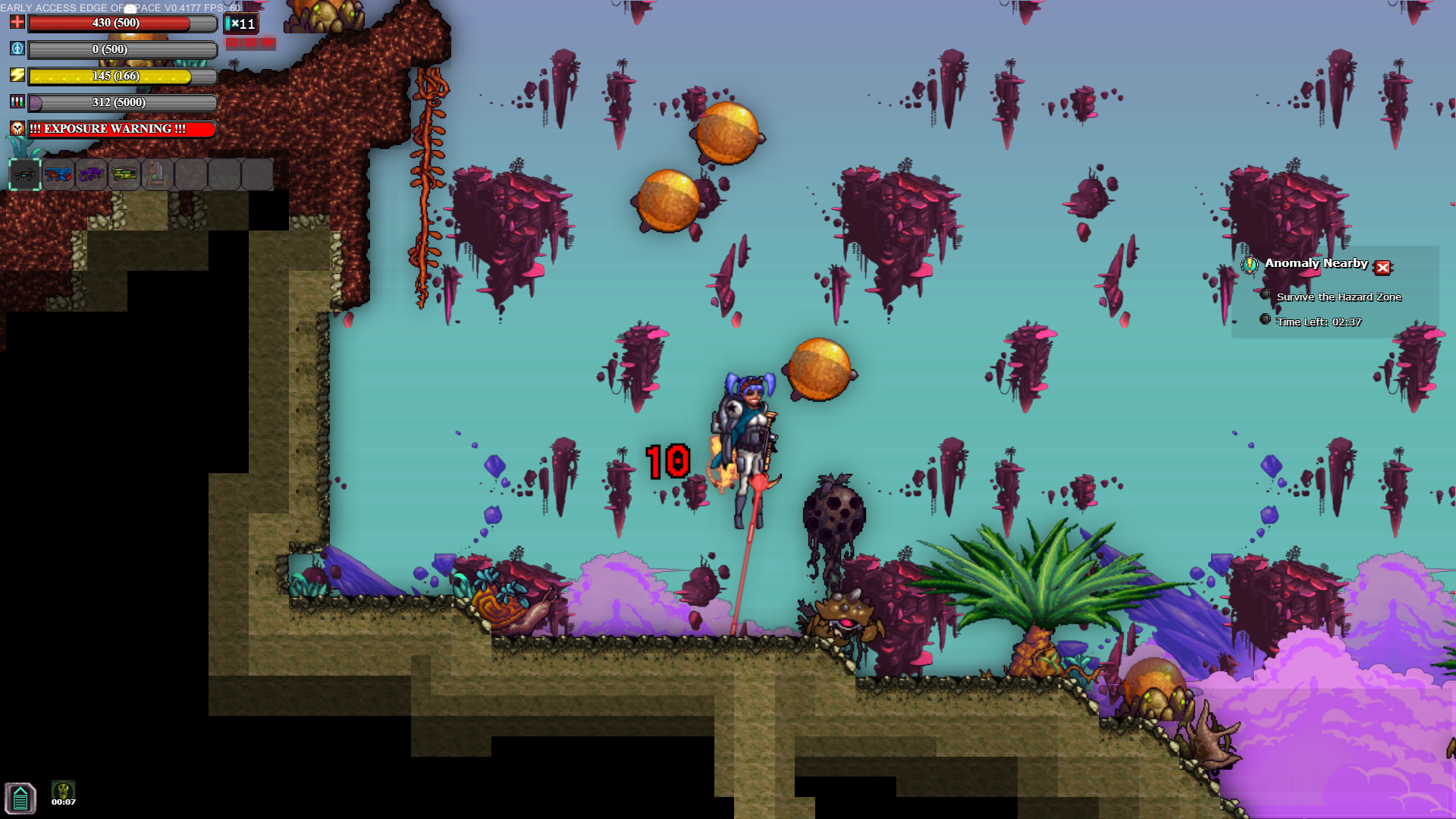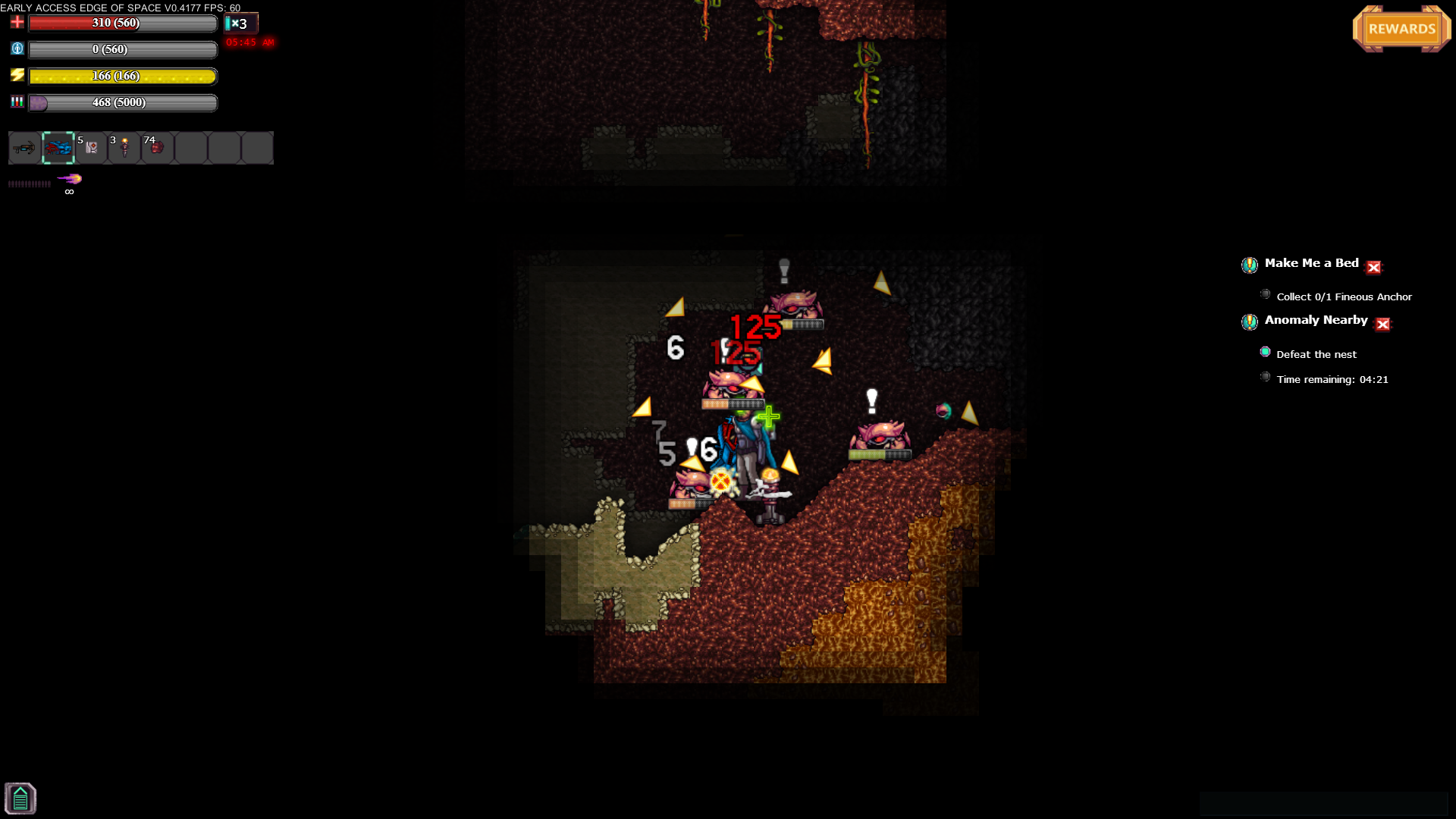Dying of radiation poisoning in Edge of Space

The thing I’ll remember most about Edge of Space is the beeping. The urgent crackle-thrum of a radiation sensor at max input, screaming about nearby danger. As radiation floods my suit and my health starts to drop, I turn and run. I keep running, but the radiation doesn’t dissipate. I start to die, and the beeping continues.
Judging an Early Access game is difficult because it is simultaneously done and not done, stable and in flux. It is both what is and what may be. For some games, those two points are pretty close together. For Edge of Space, there’s still a lot of ground to cover to get where it wants to go.
The setup is familiar: Earth is destroyed, so ships are sent out to discover and terraform new planets. The terraforming ship meets with disaster, and now you (and your friends, if this is a multiplayer adventure) are alone on a sidescrolling, two-dimensional planet full of stuff to harvest. It’s very similar to Terraria, but with a sci-fi edge.
The game’s strongest asset is its surreal, colorful world. Full of towering mushrooms and sharks with laser beams attached, one-eyed crabs and car-sized frogs. It shows off a wry sense of humor and penchant for ridiculous things, but it’s also a hint of how many weird ideas have been pushed into this game. There’s pets and decorations and armor and plasma guns and plants and flying buzzsaws and on and on. Eventually, the list of things, both serious and silly, included in the game starts to read like a manifesto published by AxeCop.

It is fun, though, after a fashion. I don’t have the sense of wonder I got from exploring in Minecraft, but there is satisfaction in carving a home for myself out of the alien dirt, lining it with stone bricks, and filling it with equipment and computer controls for my terraforming project.
But unlike Minecraft or Terraria, the combat and user interface windows are a real nightmare. With hundreds and hundreds of crafting recipes to sort through and dozens of types of resources to use, I quickly got overwhelmed. I found it hard to wander and explore, collecting as I went, and would instead decide on what I wanted to build, go out and get the ingredients, and come back. That’s one way to do it, of course, but it’s a rhythm that destroyed the pleasures of the open world for me.
Combat is also wonky and annoying. Enemies gravitate toward me and fly through me, doing damage and coming out the other side, slowing, turning, and coming back for another pass. With multiple enemies on screen at once, the result is a flailing, frustrating mess.
Keep up to date with the most important stories and the best deals, as picked by the PC Gamer team.
I see a light at the end of the tunnel for these issues, though, as playing in multiplayer made all of them more tolerable. Friends for backup made combat less of a chore, and the ability to take on special dungeons and world bosses gave me concrete goals I found lacking in singleplayer. When three of us, toting powerful shotguns and advanced suits of armor, rampaged our way through a special dungeon toward a glittering reward, I saw the shape the game that Edge of Space hopes to be eventually.
Roadmaps
The real problem with Edge of Space in its current state, though, is a lack of guidance. I frequently tried to follow crafting recipes that referenced a resource I had never found, and had no idea where to find it or what it might look like. After an hour of searching, I finally found the resources I needed to craft a command node, the central CPU hub for my new base. I placed it and discovered it didn’t work; it wasn’t placed the right way. What was the right way? I have no idea. It was a big let-down after all the work I did to make it. It was an accomplishment I didn’t get to enjoy.
Now we return to the beeping: After spelunking for a long time in a generally downward direction, I dropped down to an open field on a lower level of the planet. My radiation meter, which up to that moment I didn’t know existed, filled up and started warning me that I was near something dangerous. I turned and ran away from a mysterious looking rock, assuming it was the source of the radiation.

As I ran, I started to die and respawn, working my way through my respawn tickets. I died and ran, ran and died. After running for several minutes, I decided that the entire planet below a certain altitude must be radioactive, and my only hope was to go back up. I never made it, eventually respawning at my original drop pod, miles from my fledgling base. The game’s basic tutorial had never mentioned radiation, and I had no idea why an entire continent of the planet would be inhospitable to life. My dwindling urge to explore got a little smaller still.
But, this is Early Access. A lack of guidance now doesn’t mean a lack of guidance later. However, Edge of Space still feels like an early beta build after two years of work on Steam. Though the team is dedicated, friendly, and beloved by the team’s vigorous fanbase, I wonder how much longer it might be until it shapes up. It receives monthly updates, but it seems that overall progress is quite slow.
I don’t recommend checking out Edge of Space just yet, but I am hopeful that it will find a rhythm for itself eventually, a balance between allowing discovery and providing clear directions about its rules. There are a lot of great ideas here (and a lot of great writing), but they’re still forming. Because they're forming slowly, caution seems to be the best approach.

